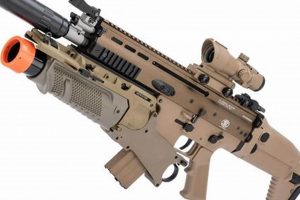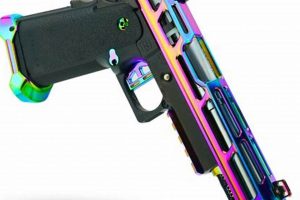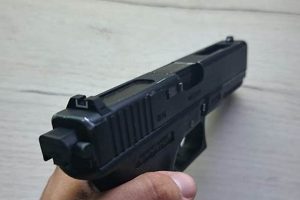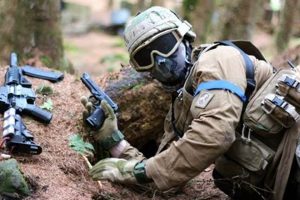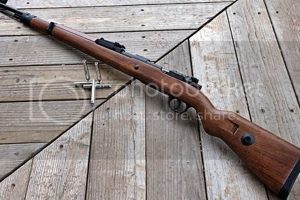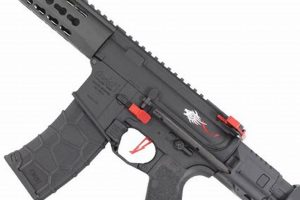The concept represents the skill of accurately targeting and hitting designated points in the sport of airsoft. Success depends on a complex interplay of factors, including equipment calibration, environmental conditions, and individual proficiency. For instance, a player who consistently hits a small target at a distance demonstrates developed capabilities in this area.
Achieving proficiency offers a significant advantage in competitive scenarios. It enhances tactical effectiveness, improves engagement outcomes, and contributes to team success. Historically, the pursuit of greater precision has driven advancements in airsoft gun technology and training methodologies, reflecting its central role within the sport.
The following sections will delve into the specific equipment, techniques, and training regimens that contribute to the development of this crucial skill within the airsoft domain. These elements are integral to understanding how participants can improve their performance and achieve a higher level of accuracy on the field.
Precision in Airsoft
Enhanced precision in airsoft requires dedication and a systematic approach to skill development. This section outlines actionable steps players can implement to improve their targeting accuracy and overall performance.
Tip 1: Equipment Calibration: Consistent accuracy necessitates properly calibrated equipment. Ensure the airsoft gun’s hop-up is adjusted for optimal projectile trajectory, accounting for the weight of the BBs used.
Tip 2: Sight Acquisition Practice: Repeatedly practice acquiring a clear sight picture. This involves quickly and accurately aligning the sights with the intended target, minimizing time spent aiming.
Tip 3: Trigger Control Mastery: Smooth and controlled trigger pull is essential. Avoid jerking the trigger, as this will disrupt the gun’s stability and affect shot placement. Focus on a slow, deliberate squeeze.
Tip 4: Stance and Stability: Adopt a stable and consistent shooting stance. A solid foundation minimizes body movement, contributing to improved accuracy. Experiment with different stances to find one that provides optimal stability.
Tip 5: Windage and Elevation Adjustment: Learn to compensate for wind and elevation. Observe the environment and adjust the aiming point accordingly. Experience will refine the ability to accurately estimate these factors.
Tip 6: Consistent BB Quality: Use high-quality BBs from a reputable manufacturer. Inconsistent BB weight and shape can significantly impact shot accuracy. Maintaining consistency in ammunition is paramount.
Tip 7: Regular Maintenance: Ensure the airsoft gun is properly maintained. Regular cleaning and lubrication will keep the internal mechanisms functioning smoothly, contributing to consistent performance.
Implementing these tips requires diligent practice and attention to detail. The cumulative effect of these improvements will result in a noticeable increase in accuracy and effectiveness on the airsoft field.
The following section will explore advanced techniques and strategies for further honing precision skills in various scenarios.
1. Consistency
Consistency forms a foundational pillar underpinning accuracy in airsoft. Without a repeatable set of actions and predictable equipment behavior, achieving a high level of precision becomes exceedingly difficult. The following facets highlight the critical elements of consistency and their relationship to targeted accuracy.
- Stance and Grip Uniformity
Maintaining an identical stance and grip for each shot is crucial. Variations in body position or hand placement alter the gun’s orientation, leading to inconsistent projectile trajectories. A shooter must establish a repeatable physical foundation to minimize shot-to-shot deviation. For instance, a slight shift in weight distribution can cause measurable differences in impact points at longer ranges.
- Trigger Pull Control
Applying consistent pressure to the trigger is paramount. Jerking or “slapping” the trigger introduces unwanted movement to the airsoft gun, disrupting the aiming process. A smooth, controlled squeeze, applied identically each time, minimizes this disturbance and promotes consistent shot placement. Developing this skill requires deliberate practice and focused attention to trigger manipulation.
- Equipment Maintenance and Performance
Regular maintenance ensures consistent equipment performance. A dirty barrel or a worn hop-up bucking can drastically alter projectile behavior. Cleaning, lubrication, and timely replacement of worn parts are essential for maintaining predictable performance characteristics. Neglecting maintenance introduces variability that undermines consistency in targeting.
- Ammunition Quality and Selection
Using consistent, high-quality ammunition is vital for precision. Variations in BB weight, size, or surface finish can significantly impact trajectory. Selecting a reputable brand and ensuring consistent BB quality from batch to batch minimizes these inconsistencies and contributes to more predictable shot placement. Switching between different BB brands or grades mid-game disrupts established aiming references.
These elements of consistency, when diligently addressed, contribute significantly to enhanced accuracy in airsoft. The ability to repeat physical actions, maintain equipment performance, and utilize consistent ammunition allows the shooter to develop a refined understanding of their airsoft gun’s behavior, translating into greater precision on the field. The pursuit of accuracy is, therefore, intrinsically linked to the cultivation of unwavering consistency in all relevant aspects of the sport.
2. Calibration
Calibration is fundamental to achieving precision in airsoft. It directly influences projectile trajectory and impact point. Meticulous adjustment of various components ensures consistent performance, mitigating deviations caused by manufacturing tolerances or environmental factors. An improperly calibrated airsoft gun is inherently inaccurate, regardless of the operator’s skill. For instance, if the hop-up unit applies excessive backspin, the BB will deviate upwards, resulting in shots overshooting the intended target. Conversely, insufficient hop-up will cause the BB to drop prematurely.
The hop-up unit requires precise adjustment to impart the correct amount of backspin to the BB, counteracting gravity and extending its effective range. Sights, whether mechanical or optical, necessitate alignment with the barrel to ensure that the point of aim corresponds to the point of impact. Airsoft guns equipped with adjustable gas systems also demand calibration to optimize gas flow for consistent muzzle velocity. Variances in gas pressure or valve timing can lead to unpredictable shot behavior. The correlation between meticulous calibration and improved accuracy is directly observable on the airsoft field: A correctly calibrated weapon system yields tighter shot groupings and increased hit probability.
In summary, calibration is not merely a preliminary step but a continuous process. Regular checks and adjustments are essential to maintain optimal performance. Neglecting calibration undermines the potential for accuracy, highlighting its indispensable role in achieving superior targeting proficiency. The understanding and application of proper calibration techniques are critical for any airsoft participant seeking to maximize their effectiveness in gameplay.
3. Technique
Technique represents the practical application of learned skills and refined methods to achieve accuracy in airsoft. It encompasses physical maneuvers, cognitive processes, and adaptive strategies employed during gameplay. Proficiency in technique directly translates to improved targeting capabilities.
- Target Acquisition and Tracking
Effective target acquisition involves quickly and accurately identifying and prioritizing potential targets within the field of view. Tracking requires maintaining visual contact with the target while accounting for its movement. A skilled player can rapidly shift focus between multiple targets and predict their trajectories, leading to more opportune and accurate shots. This is crucial in dynamic scenarios where targets are fleeting and engagement windows are brief. For instance, during close-quarters combat, a player adept at target acquisition and tracking can react faster and deliver more precise shots than an opponent lacking this skill.
- Breathing Control and Stability
Controlling breathing promotes physical stability, which is critical for maintaining a steady aim. Holding the breath momentarily before and during the trigger pull minimizes body movement and enhances shot accuracy. Skilled players learn to coordinate their breathing with their aiming process, using the natural pauses in their breathing cycle to stabilize their body. This technique is particularly beneficial when engaging targets at longer distances, where even minor movements can significantly impact shot placement.
- Adaptive Aiming Adjustments
Adaptive aiming involves making real-time adjustments to the point of aim based on environmental factors and target movement. This includes compensating for windage, elevation, and target speed. A proficient player can quickly assess these variables and adjust their aim accordingly, increasing the likelihood of a successful hit. For example, a player engaging a moving target in windy conditions must lead the target and account for wind drift to achieve a precise shot.
- Situational Awareness and Tactical Positioning
Situational awareness and tactical positioning indirectly contribute to accuracy by allowing the player to engage targets from advantageous locations with clear lines of sight. By anticipating enemy movements and positioning themselves strategically, players can minimize exposure and maximize their shooting opportunities. For example, a player who flanks an enemy position gains a clear shot from an unexpected angle, increasing their chances of a successful engagement. Situational awareness informs positioning, which directly impacts the ease and precision of aiming.
These facets of technique represent a holistic approach to enhancing accuracy in airsoft. While equipment and environmental factors play a role, the individual’s proficiency in these techniques ultimately determines their effectiveness on the field. The continuous refinement of these skills through practice and experience is essential for achieving and maintaining a high level of precision.
4. Environment
The surrounding environment exerts a significant influence on projectile trajectory in airsoft, thereby affecting accuracy. Atmospheric conditions such as wind, temperature, and humidity contribute to deviations from the intended point of impact. Wind, in particular, can cause horizontal displacement of the BB, necessitating adjustments to the aiming point. Temperature variations alter air density, impacting the BB’s flight path and range. Humidity levels can affect the BB’s surface characteristics and aerodynamic properties. The interplay of these environmental factors demands continuous assessment and adaptation from the airsoft participant.
Terrain features also play a critical role. Uneven ground, vegetation, and obstacles introduce complexities to target acquisition and shot execution. Shooting uphill or downhill requires compensating for the angle of inclination to prevent overshooting or undershooting the target. Dense foliage can obstruct the BB’s path, diminishing its velocity and altering its trajectory. An urban environment presents challenges such as wind tunnels and unpredictable ricochet angles. Understanding the unique characteristics of each playing field is crucial for developing effective strategies and maximizing accuracy. Consider a scenario where a player is positioned on elevated terrain. The downward angle requires a downward adjustment of the aiming point. Failure to account for this angle will result in the shot impacting above the intended target.
In conclusion, the environment is an inseparable component of the accuracy equation in airsoft. Recognizing and responding to environmental variables demands acute observation skills and adaptability. While meticulous equipment calibration and refined technique are essential, the environment introduces a dynamic element that requires constant evaluation and proactive adjustments. A comprehensive understanding of environmental influences is thus crucial for achieving consistent precision on the airsoft field, allowing participants to translate skill and equipment effectiveness into tangible results.
5. Equipment
The selection and maintenance of appropriate equipment are fundamentally linked to achieving accurate targeting in airsoft. The performance characteristics of the airsoft gun, sighting systems, and ancillary gear directly influence the operator’s ability to consistently hit intended targets.
- Airsoft Gun Platform and Internal Components
The base airsoft gun serves as the foundation for accuracy. Factors such as barrel quality, hop-up unit design, and the consistency of the internal mechanisms significantly impact projectile trajectory. For example, a tightbore barrel, characterized by a smaller internal diameter, can enhance accuracy by reducing BB wobble during flight. Similarly, a well-designed hop-up unit, which imparts backspin to the BB, stabilizes its flight path and extends its effective range. The consistency of the gearbox, including the piston, cylinder, and gears, contributes to shot-to-shot velocity consistency, a crucial factor for predictable ballistics. Choosing a platform with inherent accuracy potential and upgrading critical internal components can substantially improve targeting capabilities.
- Sighting Systems (Optics and Iron Sights)
Sighting systems provide the visual reference point necessary for aiming. Iron sights, while simple, offer a reliable aiming solution. Optical sights, such as red dot sights and magnified scopes, enhance target acquisition and precision, particularly at longer ranges. The proper selection and zeroing of a sighting system are critical for ensuring that the point of aim corresponds to the point of impact. For example, a red dot sight allows for rapid target acquisition in close-quarters combat, while a magnified scope provides greater precision for engaging distant targets. A poorly aligned or incorrectly zeroed sight renders even the most accurate airsoft gun ineffective.
- Ammunition (BB Quality and Weight)
The quality and weight of the ammunition directly influence accuracy and range. High-quality BBs, manufactured with consistent dimensions and weight, contribute to predictable projectile trajectories. Variations in BB weight or shape can introduce inconsistencies, leading to erratic shot patterns. The appropriate BB weight should be selected based on the airsoft gun’s power output and intended engagement range. For example, heavier BBs generally perform better at longer ranges and in windy conditions, while lighter BBs are suitable for lower-powered airsoft guns and close-quarters combat. Utilizing consistent, high-quality BBs is essential for maintaining accuracy.
- Support Gear (Slings, Grips, and Bipods)
Support gear enhances stability and control, contributing to improved accuracy. Slings provide a stable shooting platform, distributing the airsoft gun’s weight and reducing fatigue. Grips, such as vertical foregrips, improve weapon handling and control, allowing for more precise aiming. Bipods offer enhanced stability when shooting from a prone or supported position. While not directly impacting the airsoft gun’s performance, these accessories contribute to the operator’s ability to maintain a stable and consistent shooting stance. For instance, a bipod can significantly reduce wobble when engaging targets from a distance, resulting in tighter shot groupings.
The synergistic effect of selecting high-quality components, configuring them appropriately, and utilizing supporting gear maximizes the airsoft gun’s inherent accuracy potential. The judicious choice and meticulous maintenance of equipment are thus essential for achieving superior accuracy and effective gameplay.
Frequently Asked Questions Regarding Precision in Airsoft
The following section addresses common inquiries and misconceptions surrounding the pursuit of accuracy within the context of airsoft. The aim is to provide clear, concise, and informative answers to pertinent questions.
Question 1: What is the most significant factor influencing precision in airsoft?
While numerous elements contribute, consistency is paramount. Consistent stance, trigger pull, and equipment maintenance are foundational to achieving repeatable accuracy.
Question 2: How does hop-up adjustment affect projectile trajectory?
The hop-up unit imparts backspin to the BB, counteracting gravity. Proper adjustment extends range and improves stability. Incorrect settings lead to overshooting or undershooting the target.
Question 3: Does BB weight impact accuracy?
Yes. Heavier BBs generally offer improved stability in windy conditions and at longer ranges, while lighter BBs may be suitable for close-quarters engagements with lower-powered airsoft guns.
Question 4: How important is regular maintenance for airsoft gun performance?
Regular maintenance is critical. Cleaning, lubrication, and timely replacement of worn parts ensure consistent operation and predictable projectile behavior.
Question 5: Can skill compensate for inadequate equipment?
Skill can mitigate some limitations, but ultimately, inadequate equipment restricts potential accuracy. Quality equipment, properly maintained, provides a solid foundation for skill development and effective performance.
Question 6: How do environmental factors impact shot accuracy?
Wind, temperature, and terrain all influence projectile trajectory. Adjustments to aiming point are necessary to compensate for these variables.
Achieving superior targeting proficiency in airsoft is a multifaceted endeavor, demanding attention to detail and a systematic approach. Mastery of these concepts will contribute to improved performance.
The subsequent section will examine advanced techniques for optimizing equipment performance and refining precision skills.
The Pursuit of True Aim Airsoft
This exploration has detailed the multifaceted nature of achieving accuracy in airsoft. From meticulous equipment calibration and consistent technique to astute environmental awareness, numerous interconnected factors contribute to the attainment of precision. Mastery hinges upon a comprehensive understanding and practical application of these principles.
The quest for improved targeting is a continuous journey, demanding dedication and a commitment to ongoing refinement. Sustained effort in these areas will undoubtedly enhance effectiveness and elevate the level of gameplay. The pursuit of true aim remains a defining characteristic of the dedicated airsoft participant.


